Xi'an-The other side of warmth, literature and art (another 5-day tour)
[Foreword]:
The most important mark on the ancient city of Xi'an is two words-[History]. With a history of more than 7000 years of civilization, more than 3100 years of city construction, and more than 1200 years of capital construction, it is the first capital city in history to be called "Beijing".
Too many people have written articles and travel notes about Xi'an, so this time I wanted to be innovative at the beginning of my trip planning, showing it from a novel perspective and different side. Presenting a petty bourgeoisie girl's own comic life, the ancient city in her eyes.
[Trip]
D1: Shanghai--Xi'an--City Wall--Shuyuan Gate--Shuncheng Lane--Bell Tower and Drum Tower--Defa Changzi Banquet
D2: Famen Temple--Qianling--Tongshengxiang Mutton and Steamed Bubbles--Huimin Street
D3: Qin Shihuang Terracotta Warriors and Horses-Huaqing Palace-The Legend of Camel Bell
D4: Dahua 1935--Daming Palace Ruins--Yongxing Square--Big Goose Pagoda North Square (looking at the fountain)--Big Goose Pagoda South Square--Tang Dynasty Sleepless City
D5: Shaanxi History Museum--Beautiful meal-Red-eye flight back to Shanghai
Specific tour routes
D1: Shanghai--Xi'an--City Wall--Shuyuan Gate--Shuncheng Lane--Bell Tower and Drum Tower--Defa Chang Dumpling Banquet
[Plane meal]
Let me sigh with emotion. China Eastern Airlines 'flight meals have not been so rich in a long time. This time, I borrowed the light of international flights, so I specially wrote a description.



[Days Inn]
Days Inn on North Street is convenient for travel and has a family room that can accommodate a family of three or four. The long corridor is very traditional. The service is humane and worth living in.



[City Wall]
Every time I come to Xi'an, I come to the city wall. Every time I invite an explanation, I will have different insights and gains.


[Yongning Gate]Commonly known as the South Gate, it is the oldest and longest used gate in Xi'an. It was built in the early Sui Dynasty. Called Anshangmen, it was renamed Yongning Gate in the Ming Dynasty.

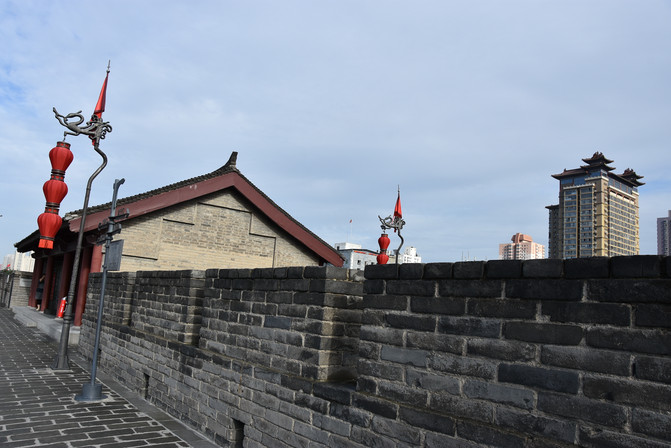

Xi'an Ming City Wall is the largest and most completely preserved ancient city wall in China, with a circumference of 13.74 kilometers
It is the first batch of national key cultural relics protection units and national 5A scenic spots. Xi'an City Wall in the broad sense includes Xi'an Tang City Wall and Xi'an Ming City Wall, but generally refers specifically to Xi'an Ming City Wall in the narrow sense. (marked by dark blue dotted lines)

There are four main gates of the Xi'an City Wall: Changle Gate (East Gate), Yongning Gate (South Gate), Anding Gate (West Gate), and Anyuan Gate (North Gate). These four gates are also the original gates of the ancient city wall. Since the Republic of China, many new gates have been opened to facilitate access to the Ancient City. So far, there are 18 gates in the Xi'an City Wall.
[Wengcheng]--The name of catching turtles in a barrel
Among them, Yongning Gate, Anyanyuan Gate, Changle Gate and Anding Gate were the original gates of Xi'an Ming City Wall. Due to the military defense needs at that time, they were all single gate openings, and three city walls were built, and between the two city walls, a Weng City was formed.


◆ There are upper and lower holes on the city wall at regular intervals. The purpose is to shoot arrows from the top and splash hot oil from the bottom to resist foreign aggression.

[Arrow Tower]--A tower with far-sighted and archery windows around the ancient city wall
There is an arrow tower every 120 meters. Why? Because the effective distance of the arrow at that time was 60 meters, 120 meters could just make up for the blind spot in the middle. Arrow Tower is a very scientific ancient military building.

[Horse Face]--Rectangular piers and piers protrude from the city wall at a certain distance to facilitate defenders to attack incoming enemies from the side. These piers and piers are called the enemy's city defense facilities and are commonly known as "horse faces"


[The outer wall is high and the inner wall is low]
It is best to ask for an explanation to visit the city wall. You can walk, take a battery bike, or ride a bicycle. Use the word "slow" to experience the amazing military facilities.
[Bicycle Rental Office]


◆ [In order to protect cultural relics, Xi'an City Wall has been repaired in recent years]

[Make children fall in love with history and participate in it through different forms]





[One side is history, the other side is fashion]

[Forest of Steles Museum]
Coming out of the Wenchang Gate of the city wall is the Forest of Steles Museum.
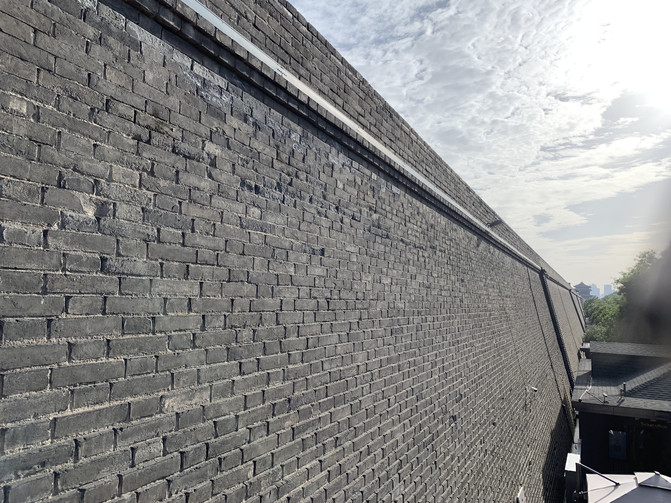






[College Gate]
What Xi'an people usually call the academy gate refers to a pedestrian street from the forest of steles to the gate of Guanzhong Academy. Both sides of the street are all imitation Tang buildings. During the day, it is a painting and calligraphy street with a strong literary atmosphere; at night, it is a snack street with strong Xi'an characteristics.
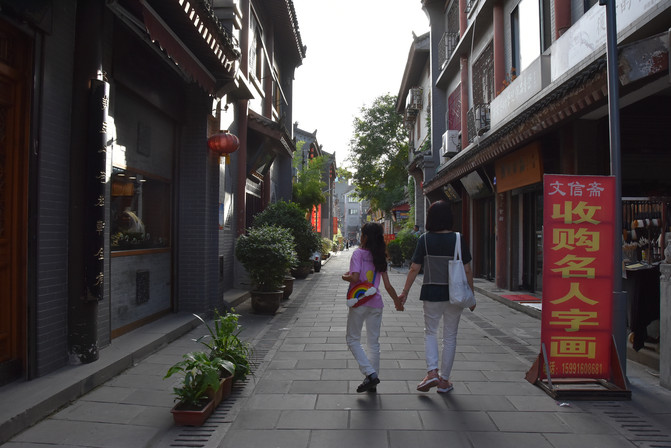

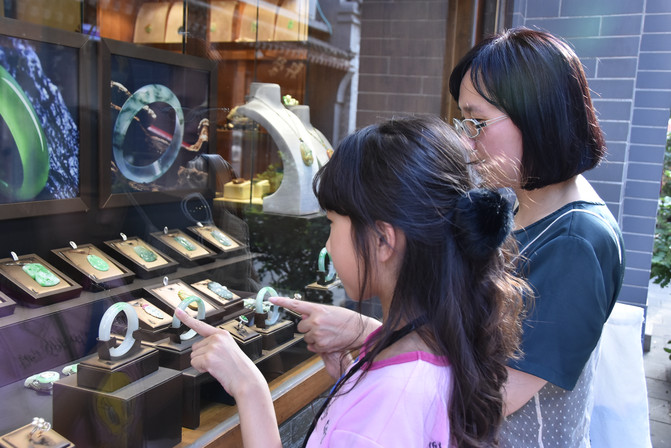



During the last trip to Xi'an, the Academy Gate was introduced in great detail, so I will skip it this time.
[Shuncheng Lane]
Shuncheng Lane is divided into sections, like bamboo, and each joint is a double door with endless traffic. When encountering Hanguangmen, Zhuque Gate, Nanmen and Wenchang Gate, you will have to turn. On one side is the majestic ancient city wall, and on the other side is the beautiful and dignified ancient building. Inside and outside the city wall, the battlements and cornices are integrated. In the alleys along the bluestone path, restaurants, bars, coffee bars, and youth hostels with different styles are gathered.
When you want to stroll around the corner under the city wall, Shuncheng Lane is a must-know.






[Bell Tower]
Xi'an Bell Tower is located in the center of Xi'an City, at the intersection of four streets, east, west, north and south in the Ming City Wall. It is the largest and most completely preserved Bell Tower in China. It was built in 1384 in the 17th year of Hongwu of Emperor Taizu of the Ming Dynasty and was first built at the present Guangji Street Corner. Opposite the Drum Tower, it was relocated to this site in the 10th year of Wanli of Emperor Shenzong of the Ming Dynasty (1582).
There are 6 chime performances every day.
[Bell Tower during the day]
With dark green glazed tiles, gilded roofs, and thick brick walls, the bell tower stands tall, and vehicles pass by, as if the long river of history passed in front of it.

[Bell Tower at Night]
Against the backdrop of the lights, the green ones are greener, the red ones are redder, and the gold ones are more shiny. From a distance, they look more like the Tang Dynasty.

[Drum Tower]
The Drum Tower is next to Hui Street. The Drum Tower is a beam-frame wooden pavilion building with two floors and three floors with double eaves. There are no nails in the structure of the entire building. The eaves and flat seats use the principle of bucket arch construction. The exterior of the building is quaint and majestic, full of national characteristics.


Architectural painting is also one of the main features of traditional Chinese architecture. Various patterns depicted in rich colors not only have a decorative effect, but also protect the wood. In China's autocratic monarchy society, the use of architectural colors also has strict hierarchical restrictions: the most noble gold, pearl and yellow gold seals are the first class and are only used for buildings symbolizing imperial power; the green and green spiral paintings are second, used for the residences of civil and military officials; the Su style painting ranks third. Xi'an Drum Tower uses harmony seal painting and winding Zi painting respectively, and painted with pink golden dragons, which has become a masterpiece of ancient architectural painting. Throughout the entire Ming Dynasty, the architectural shape and level of Xi'an Drum Tower even surpassed that of Nanjing, the capital of the time.


◆ Under the third eaves of the Drum Tower, a plaque hangs in the north and south, with the south being the "Place of Prosperity of Civil and Military Affairs" and the north being the inscription "Sound in the Sky".

[Defa Changzi Dumpling Banquet]
In other words, there are so many famous snacks in Xi'an that I can't count them on one hand. Why choose a dumpling banquet?
We thought that the first meal in Xi'an should have a sense of ceremony.
Founded in 1935, Defa Chang is a well-known Chinese time-honored catering industry at home and abroad. It is a national super hotel and a Chinese AAAAA green hotel. It is located in the center of the ancient city of Xi'an, surrounded by the Bell Tower to the east and the Drum Tower to the west.
It is also the dumpling banquet with the most complete supply of varieties and the largest operation scale.




Many dumplings are exquisite handicrafts. Some look like butterflies, some look like penguins, some look like green leaves, and some look like goldfish, flying in the sky, like clouds, and like pearls. The names are also poetic: colorful butterflies flying, fish jumping over the dragon gate, oolong lying on the snow, dragons making trouble in the sea, green jade rabbits, sending charcoal in the snow, sailing thousands of miles, etc. All of them are pleasing to the eye, making people both salivate and can't bear to use chopsticks. The last chrysanthemum hot pot pearl dumplings are even more exciting. The dumpling banquet has one dumpling shape and one dumpling shape, and guests can feast their eyes and taste.
D2: Famen Temple--Qianling--Tongshengxiang Mutton and Steamed Bubbles--Huimin Street
[Famen Temple]--An underrated Ming Temple
◆ Famen Temple, also known as the "Real Pagoda", is located in Baoji City, the hometown of Emperor Yan and the hometown of bronzes. It is a national key cultural relic protection unit and a national AAAAA tourist attraction.





◆ It has a history of more than 1700 years. It was renamed "Famen Temple" during the Zhou Wei, Sui and Tang Gaozu. Famen Temple is known as the royal temple. It has become a Buddhist holy place that the whole country looks up to because of the placement of Sakyamuni Buddha's finger bones.



[Relic]
From May 5 to 12, 1987, a total of 4 relics were discovered during the opening of the relics underground palace. Two of them were made of white jade, and the other was a relic of a senior monk. These three pieces belong to the "shadow bones" and are placed together with the "spirit bones" to protect the latter. The "spiritual bone" is yellow in color and has granular secretions like bone. It is folded at the top and bottom. It is flat on all three sides, and one side is slightly higher. At the same time, there are dotted with white mold spots attached to it. The spiritual bone is 40.03 mm long, the upper width is 12.11 mm, the upper cavity diameter is 13.75 mm, the lower cavity diameter is 16.5 mm, and weighs 16.2 grams. After expert identification, this piece is the true Buddha bone. This Buddha bone is a unique relic in the world today and the supreme Buddhist world. Famen Temple has also become a Buddhist resort with the excavation of the real relic.
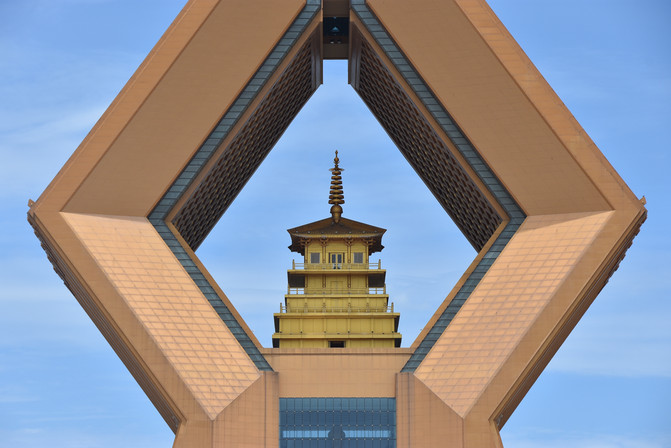

◆ Famen Temple underground palace is the largest underground palace under the tower ever seen. In the underground palace of Famen Temple in Baoji, the highest Buddhist treasures such as Sakyamuni Buddha's finger bone relics, copper pagodas, eight-fold treasure envelopes, silver flowers and twelve rings of tin staff were unearthed. The Famen Temple Treasure Hall has more than 2,000 pieces unearthed in the underground palace of Famen Temple. National treasures and heavy artifacts of the Tang Dynasty are among the most temples in the world.


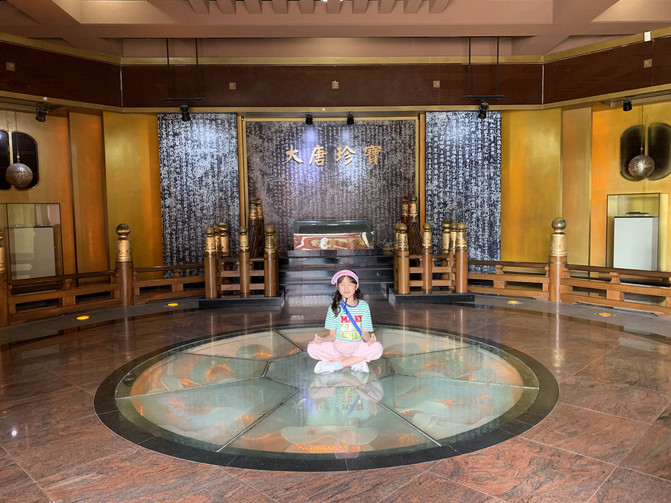
[Dense color porcelain]




[Golden Alms Bowl]


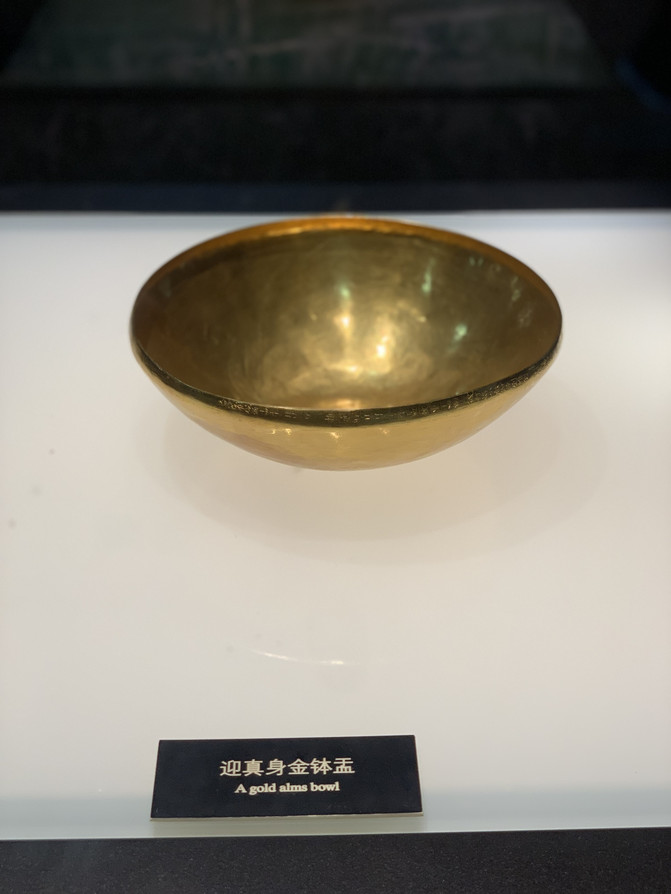
[Gold and Silver Equipment]


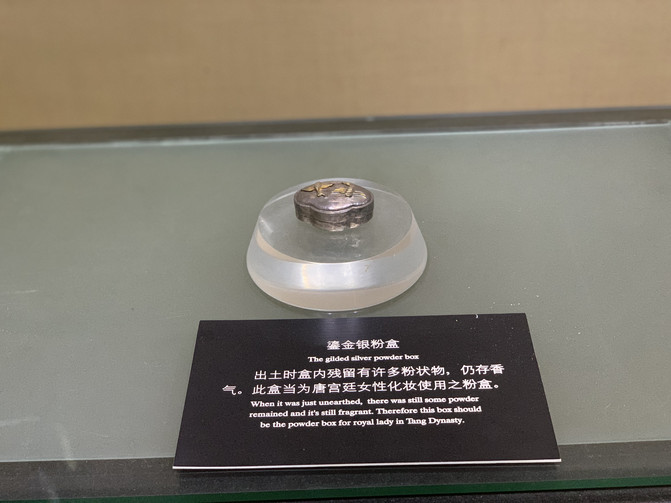


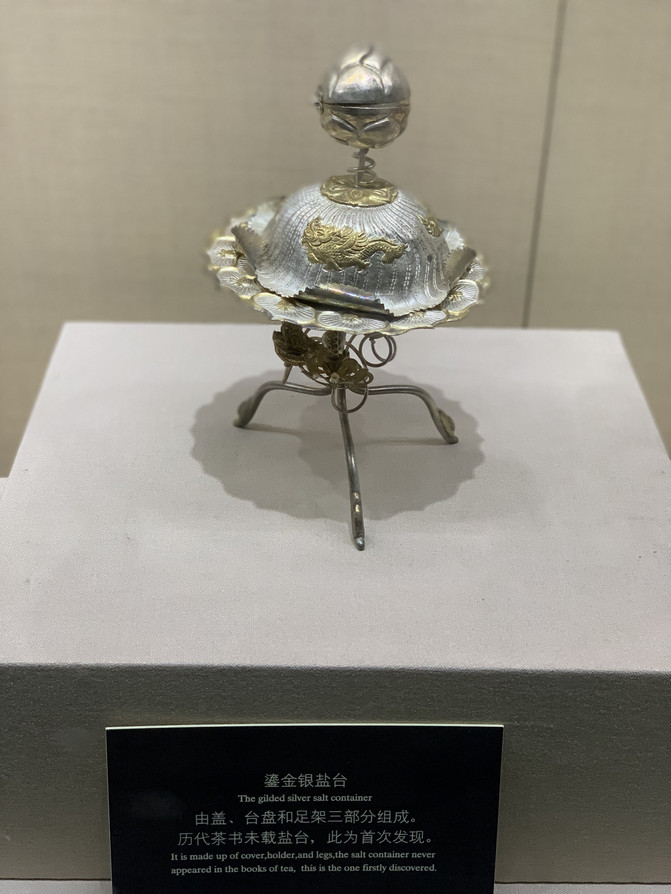
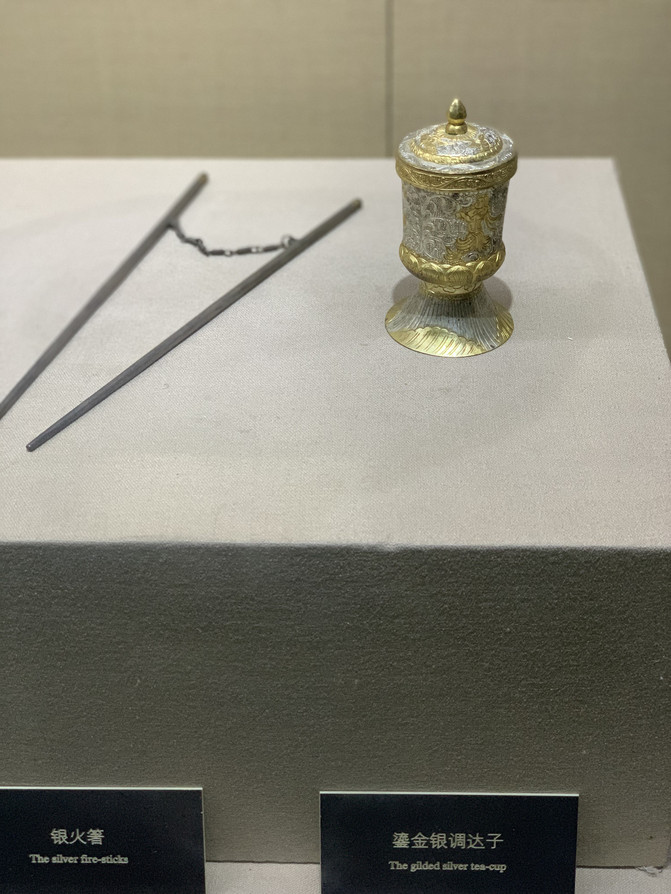


[Glass ware]

The eight treasure envelopes have eight layers in total, of different sizes, layer upon layer, and are unveiled one after another, giving dazzling light. The eight treasure letters are from the outside to the inside: the eighth, silver-edged sandalwood treasure letter. From the appearance, this is an exquisite black lacquer wood letter, in the shape of a cube, with a length, width and height of 30 centimeters. It has carved silver ribs. The whole body is made of extremely precious sandalwood. The inner wall is painted with black lacquer, black and shiny. The so-called top is a letter with an inclined upper edge on the cover. This wooden letter was seriously rotten when it was discovered. The seventh level, the four golden kings top the silver treasure letter. The sixth level is a silver treasure letter with a plain face. The fifth level is that the golden Tathagata says that the silver treasure letter is the top of the silver treasure letter. The fourth level is the six-armed Guanyin Pure Gold Top Treasure Letter. The third weight is a pure gold treasure letter in a gold basket with precious mother-of-pearl. The second layer is a gold basket with precious mother-in-pearl and decorated with a martial artist's stone treasure letter. When you open it to the innermost layer, you will see the first treasure letter, named a pure gold tower with a pearl roof, single eaves and four doors. The eaves at the top of the tower are high. There is a small silver column on the base of the golden tower, only 11 centimeters high. (Attached a photo in the first travel trip to Xi'an)
[Qianling]
Tang Gaozong and Empress Wu Zetian were buried together, covering an area of 40 square kilometers. The construction method of "turning mountains into mausoleum" is adopted.
Qianling Mausoleum is the best preserved main tomb of the 18th Tang Mausoleum, and it is also the only tomb of the Tang Mausoleum that has not been stolen.


wordless monument






[Tongshengxiang Roujiamo]
Tongshengxiang Restaurant was built in 1920 and is located next to the Drum Tower. Must-order: Mutton steamed buns.
First break them into pieces, then pinch them little by little, to the size of soybeans, and then hand them over to the master to cook the buns. Remember to use it with a "bubble companion" when eating



[Hui Street]
As one of the representatives of Xi'an customs, Xi'an Hui Street is the collective name of many streets in the Hui Street Area. It consists of several streets including Beiguangji Street, Beiyuanmen, Xiyang City, Dapiyuan, Huajue Lane, Sajinqiao, behind the Bell and Drum Tower.
Currently, there are more than 60,000 Hui Muslim communities here. Many streets in the block have a strong Islamic style, with halal food cities, ethnic shopping centers, mosques and Hui living areas "complementing each other." It is one of the must-see attractions in Xi'an.




D3: Qin Shihuang Terracotta Warriors and Horses-Huaqing Palace-The Legend of Camel Bell
[Qin Shihuang Terracotta Warriors Museum]
Qin Shihuang Terracotta Warriors, a world cultural heritage, one of the eight wonders of the world, a national AAAAA tourist attraction, and a national key cultural relic protection unit. More than 200 foreign heads of state and government have visited and visited, becoming a golden business card of ancient China's glorious civilization and known as one of the world's top ten ancient tombs and rare treasures.
The Terracotta Warriors and Horses Museum of Qin Shi Huang is a large-scale burial pit in the cemetery of China's first feudal emperor Qin Shi Huang Ying Zheng, with an area of 2.18 million square meters. The museum is based on the Terracotta Warriors and Horses of Qin Shi Huang. The ruins museum was established on the original site of the Terracotta Warriors and Horses Pit. It is also the largest ancient military museum in China.



▲ (I found photos of going to the Terracotta Warriors five years ago. It is obvious that Xi'an's air management is very effective. The door of the museum has also changed a lot. The number of visitors has doubled since 5 years ago.)


◆ Terracotta Warriors is a category of ancient tomb sculptures. In ancient times, human martyrdom was practiced. Slaves were accessories of the slave owners during their lifetime. After the slave owners died, slaves were to be buried with the slave owners as sacrificial objects. Terracotta warriors are made into sacrificial objects in the shape of horses and horses (chariots, horses, soldiers).


The Qin Shi Huang Terracotta Army Museum has three terracotta warriors pits, No. 1, No. 2 and No. 3. Pit No. 1 is a main army formation with chariots and infantry, with a total area of 14260 square meters and contains about 6000 life-size pottery figurines. Pit No. 2 is the essence of the Qin Dynasty pit. It covers an area of 6000 square meters and consists of four units. The four square arrays are composed of chariots, cavalry, and crossbows. They are neat, orderly and invincible. Pit No. 3 is the command system of the military formation and covers an area of 524 square meters.





The Qin Terracotta Warriors and Horses Pit was discovered from 1974 to 1976, and the Qin Shi Huang Terracotta Warriors Museum was opened to the public at home and abroad in 1979.

[Oil Dried Noodles]
It is one of the traditional specialty pasta foods in Shaanxi. It originated in the Ming Dynasty and is most famous for its Xianyang oil sprinkled noodles. It has fresh flavor, sour and spicy flavor, and spicy flavor.
Cook the handmade noodles in boiling water and then fish them in a bowl. Lay the chopped green onion, pepper powder and other ingredients on the surface together with a thick layer of chili noodles. Pour hot vegetable oil on the seasoning, and immediately heat the oil. Boils, heat the pepper noodles and chili noodles until the bowl is full of red light, and then add appropriate amount of soy sauce and balsamic vinegar. You can also add preserved meat, tomatoes and eggs, etc. to serve with it.
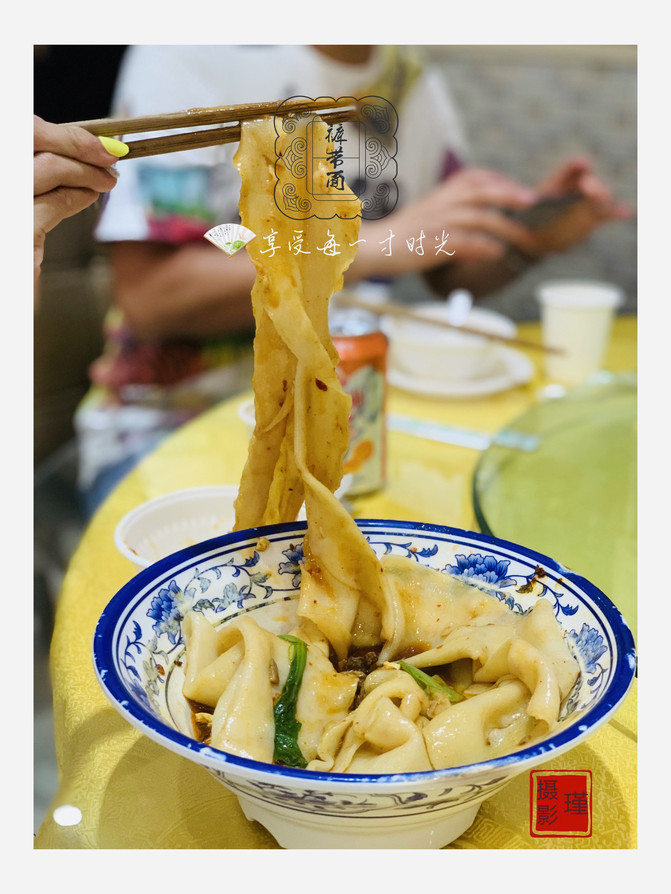
▲ The whole family feels that oil-sprinkled noodles are better than whistle noodles. I regret not having eaten more meals in Xi'an.
[Huaqing Palace]
Huaqing Palace in the Tang Dynasty was a separate palace where feudal emperors traveled. Later, it was also called "Huaqing Pool", and was also known as China's four major royal gardens, along with the Summer Palace, Yuanmingyuan, and Chengde Summer Resort.
Huaqing Palace was built in the early Tang Dynasty and flourished after Emperor Xuanzong of the Tang Dynasty came to power. Emperor Xuanzong of the Tang Dynasty carefully built such a grand Li Palace that he visited here almost every October.
This place is famous all over the world for playing with princes, taking a bath by Imperial Consort Yang, taking refuge by Empress Dowager Cixi, and remonstrance to capture Jiang.
palace gate
North Gate (Jinyang Gate), East Gate (Kaiyang Gate), South Gate (Zhaoyang Gate), West Gate (Wangjing Gate)
The inscription "Huaqing Palace" on the door plaque was inscribed by Guo Moruo.


We entered through the West Gate (Wangjing Gate),(named because it faces Chang 'an, Kyoto). Outside the door are watermelon gardens, flower viewing platforms, lotus gardens, and pink plum altar. They are the royal gardens in the palace.
[Temple of Longevity]
What you see now is the Temple of Changsheng, also known as the Jilingtai. The park was built in 742. Tang Xuanzong Li Longji and imperial concubine Yang Yuhuan swore an alliance in the Temple of Longevity on July 7, wishing that "I wish to be birds in heaven and connecting branches on earth."


[Flying Frost Hall]

The bedroom of Emperor Xuanzong and Imperial Consort Yang of the Tang Dynasty. In winter, hot spring water is circulated in the wall to make heating. Whenever snowflakes dance, the snow will fall and turn into frost when they arrive here, hence the name Flying Frost Hall. The patterns made of colored bricks and peony pictures in the pool in front of the hall vaguely reflect the luxury of the year.
[Jiulong Lake Scenic Area] consists of Jiulong Lake, Flying Frost Hall, Jiulong Bridge, Longyin Pavilion and Jiuqu Corridor.
It is also the venue for the live performance of "Song of Eternal Regret"

◆ This road leads to "Yujingxuan"(toilet)



[Yutang Ruins Museum]

[Begonia Soup]--The stone is like a Begonia flower, and it is commonly called a bath for Consort Yang



[Lotus Soup]--The bathing place of Emperor Xuanzong of the Tang Dynasty.
Lotus Soup, also known as the Imperial Tang Jiulong Hall, was built in the sixth year of Tianbao of the Tang Dynasty (747 AD). It is the Shower Soup Hall of Emperor Xuanzong of the Tang Dynasty. The soup pool is rectangular, with two floors of tables and made of bluestone. The shape is gorgeous and the scale is grand. There are double white stone lotuses in the middle, and the spring eyes pour out from the mouth of the jar and spray onto the white lotus. The area is 400 square meters.


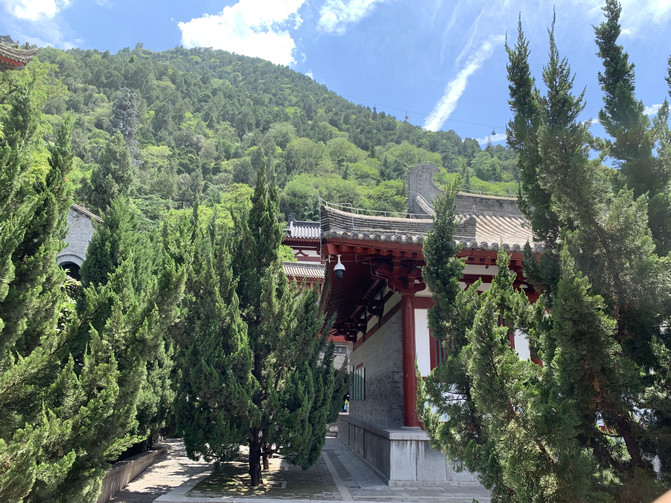

[Xijialou]
[Jade Lady Hall, Virtual Pavilion] The virtual pavilion is now called Xijia Building, and the Wenquan source below is called Xingchen Tang.



It is said that there are three hot spring outlets. This is the inscription of the No. 3 hot spring outlet.

[Star Soup]
It was used for bathing by Emperor Taizong of the Tang Dynasty. Later Emperor Xuanzong of the Tang Dynasty was renamed "Star Soup" because the shape of the "Imperial Soup" resembled the seven stars in the sky.


[Yutang Mingshi]

[Yuwang Hall]


◆ Bai Juyi's "Song of Eternal Regret" manuscript has 120 lines and 840 words throughout.

◆ Grafted pomegranate tree

[Treasure Hall]
There are many treasures in the Treasure Hall of Huaqing Palace. These 107 cultural relics range from ancient stone tools to modern times. They are arranged in historical order, showing the long history and culture of Huaqing Pool.

[Leshan Pavilion]
During the reign of Ding Chou (1877 - 1878) in the Guangxu Dynasty, the hot springs of Huaqing Palace were in disrepair for a long time. In order to relieve refugees, Shen Jiazhen, the county magistrate, prepared to use work instead of relief. He called on large local households to donate money to repair Huaqing Palace. "The appearance of all pavilions and pavilions is extremely gorgeous. They are nicknamed 'Huanyuan' and are next to 'Leshan Pavilion'

[Huan Yuan]
I came to Huanyuan, the former site of the "Xi'an Incident".
Huanyuan was built and named by Shen Jiazhen, County Magistrate of Lintong, in 1878. It covers a total area of 6000 square meters. The style of the park not only has the elegant and unique style of Jiangnan gardens, but also has the magnificent characteristics of northern gardens and temples. The main buildings include Wanghu Tower, Feixia Pavilion, Feihongqiao Bridge, Lotus Pavilion, Wujian Hall, Sanjian Hall, etc.
In 1900, when the Eight-Power Allied Forces captured Beijing, Empress Dowager Cixi was stationed here when she fled west. In October and December 1936, Chiang Kai-shek came to Shaanxi twice to supervise the war. He used the circle of the garden as a temporary mission and insisted on the erroneous proposition of "resisting the outside world must first stabilize the inside", and arranged matters for "suppressing the Communist Party" here.On December 12, 1936, the "Xi'an Incident" broke out here that shocked China and foreign countries.In February 1982, Wujianting and Sanjianting were announced by the State Council as the second batch of key cultural relics protection units in the country.

[Wanghu Tower]--It is said that the imperial concubine came here to enjoy the scenery and cool her hair after taking a bath.

[Lotus Pavilion]
Built in 1900. Before the Xi'an Incident, it served as the temporary headquarters for Chiang Kai-shek




[Five Rooms]
A group of Qing Dynasty buildings has three rooms in the east, called Tong Yin Xuan, and five rooms in the west are the five rooms where Chiang Kai-shek lived in.
In October and December 1936, Chiang Kai-shek visited Shaanxi twice. He used Huaqing Pond as his "travel center" and lived in the fifth hall. He planned a high-level military meeting here and implemented the policy of "resisting foreign forces must first stabilize the domestic forces", which aroused dissatisfaction among Generals Zhang Xueliang and Yang Hucheng, and led to the Xi'an Incident that shocked China and foreign countries on December 12.
The five rooms from west to east are Chiang Kai-shek's attendant room, bedroom, office, conference room, and secretary room. The three halls in the east were the residence of Chiang Kai-shek's personal guards. Now you can still see the numerous bullet marks left by the fierce battle back then.


[Chiang Kai-shek Guard Room]


[Chiang Kai-shek Bedroom]


[Chiang Kai-shek's Office]



◆ [Xi'an Incident Shootout Bullet Hole]


[Conference Room]




[Office of the Chief Guard]



[Chiang Kai-shek Bath Room]
"Xingyuan Bathing Room" This pool was built in the Qing Dynasty and imitated the shape of the Tang Dynasty imperial concubine pool. Kangxi in 1703 and Guangxu Cixi in 1900 bathed here. In 1936, Chiang Kai-shek came here twice and changed the pool into a walking shaft bathing room.


In 1957, the famous Peking Opera artist Mei Lanfang came here to visit and bathe, and wrote "Yang Fei Chi"


It is said that Chiang Kai-shek was killed by Zhang Xueliang and Yang Hucheng on the three stone pillars of Lishan Mountain


[White Lotus Pavilion]
Bailian Pavilion is a Ming Dynasty building in Huaqing Pool. It was demolished when Huaqing Pool was expanded in 1959. The Huaqingchi Management Office has now restored this Bailian Pavilion on the original site based on historical records and historical photos in its collection.



◆ Since Huaqing Palace opened to the public, it has received many Chinese and foreign guests.


◆ After the explanation we invited left, the group looked for scenery around the lake in the beautiful Huaqing Palace.


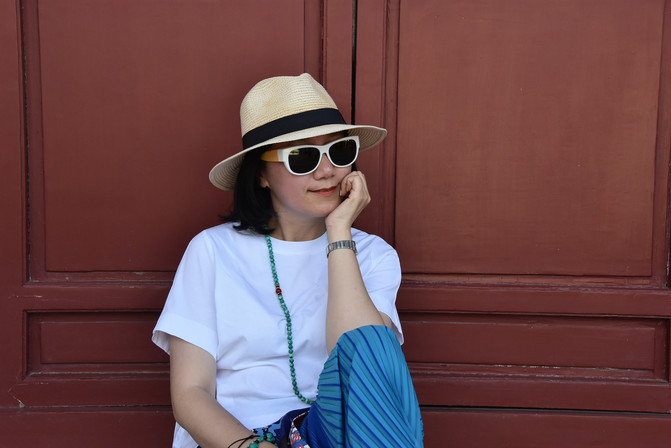


[Legend of Camel Bell]
A real-life performance that can run. The entire performance of the Legend of Camel Bell is divided into seven acts: "Time Reappears" and "Sending the King a Thousand Miles","Wolf Road in Danger","Exotic Customs","Auspicious Rain Washing the Dust","Welcome the Return of the Lang", and "The Prosperity of China".
Take a running auditorium, travel through time and space, and return to the ancient Silk Road Road of the Tang Dynasty thousands of years ago. With the ups and downs of the plot, we will revisit the ancient Silk Road in the prosperous times of the Tang Dynasty. What impressed everyone was that the entire performance boldly used 20 camels, 30 gray wolves, and thousands of tons of holy water. The thrilling performance created one climax after another.
















Charter a car throughout the journey. If you want to visit, you can watch for a while longer, and if you don't want to, you can stay for a while less. Light travel is so leisurely.
D4: Dahua 1935--Daming Palace Ruins--Yongxing Square--Big Goose Pagoda North Square (looking at the fountain)--Big Goose Pagoda South Square--Tang Dynasty Sleepless City
Literature and art is a kind of spirit, and petty bourgeoisie is a kind of feeling. When someone says that you are literary and artistic, they are actually praising you, which means that you have not let your heart grow old.
[Dahua 1935]
At first, Dahua 1935, which is adjacent to the Daming Palace ruins, was chosen because it was a place for Internet celebrities to check in. When you actually come to this place, you will find that it is an old and young, traditional and fashionable park. It retains the indelible mark of the city and its former prosperity.









◆ Dahua Textile Factory, built in 1935, was once the birthplace of the modern industrial revolution in Xi'an and even the northwest. It carries an indispensable emotional memory of the city. Mottled old factory buildings, serrated lighting windows and roofs, textile machines, Seagull cameras,"three turns and one sound",...
These are all images of Dahua.




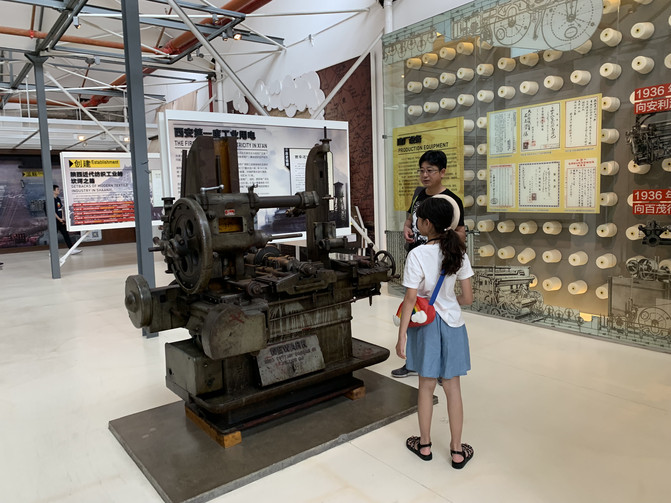








◆ Dahua 1935, some places still retain their original appearance.
Laonan Courtyard was built in 1935 and is the residence of Mr. Shi Fengxiang, the first director of Dahua Textile Factory. The design style presents a typical architectural feature of the Republic of China-a combination of Chinese and Western. First of all, the entire building continues the symmetrical style of Chinese classical architecture and the courtyard layout of several steps. But the facade actually reveals the Western style.



[Who is Shi Fengxiang?]
Rich businessman in the northwest. In 1940, Shi Fengxiang's second daughter Shi Jingyi met and fell in love with Jiang Weiguo. In 1943, the Shi and Jiang families married.


◆ This is the house where Jiang Weiguo and Shi Jingyi held their wedding



[North Courtyard] is also the location of Shi Fengxiang's Grand Mansion.
It has a typical style of the Republic of China, and every room and wall are made of solid wood.


[Old Warehouse]

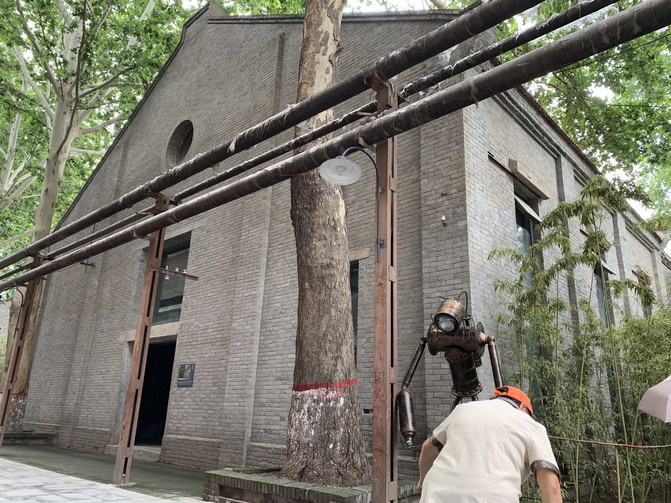

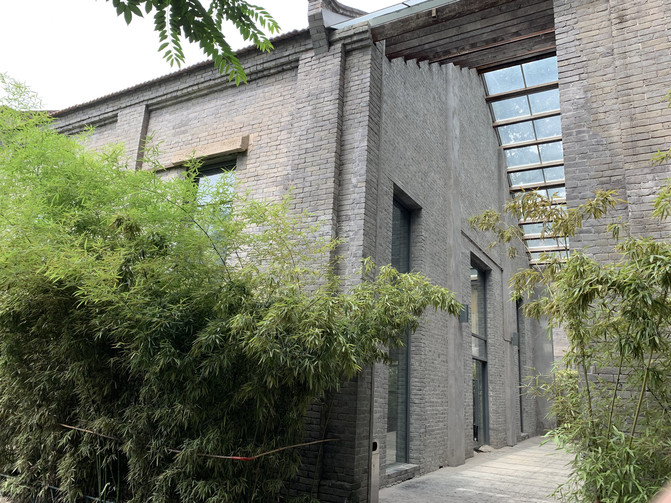
[Production Workshop]
It was originally the earliest workshop gate of Dahua Textile Factory. The designer preserved its original appearance, making it a distinctive historical landscape.
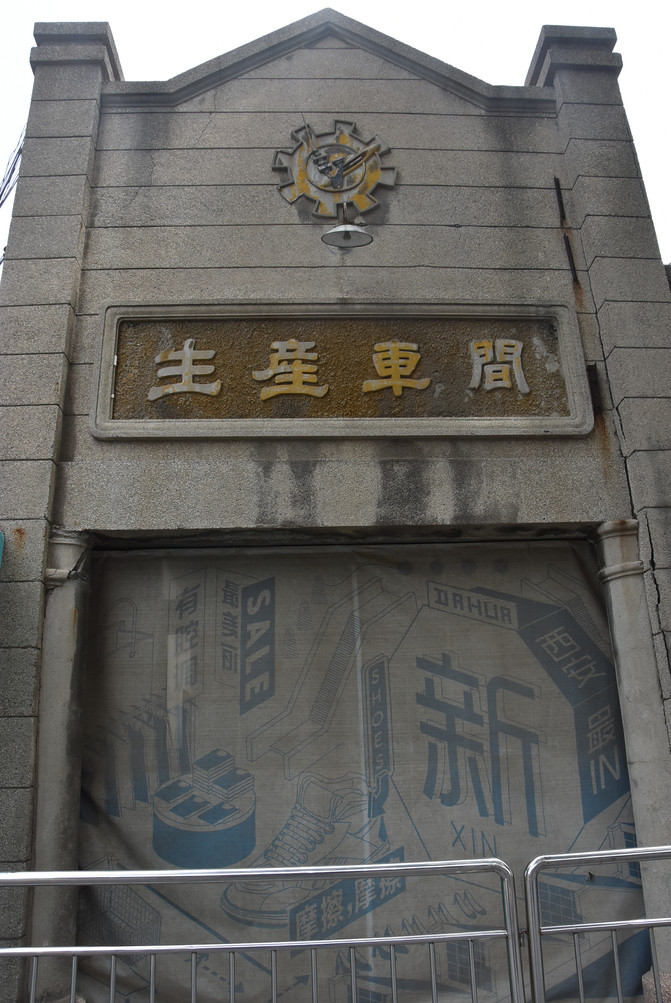
[Culture and Art Center]
It was transformed from the boiler room and coal yard of the original Dahua Textile Factory. The three cylindrical buildings with scattered heights and heights were thought to be chimneys, but they were actually dust removal towers from the 1980s.


In addition to some buildings with memories, there are also modern, smart, pyrotechnic shops that have taken root, restaurants, cafes, dessert shops, art shops, bookstores,...



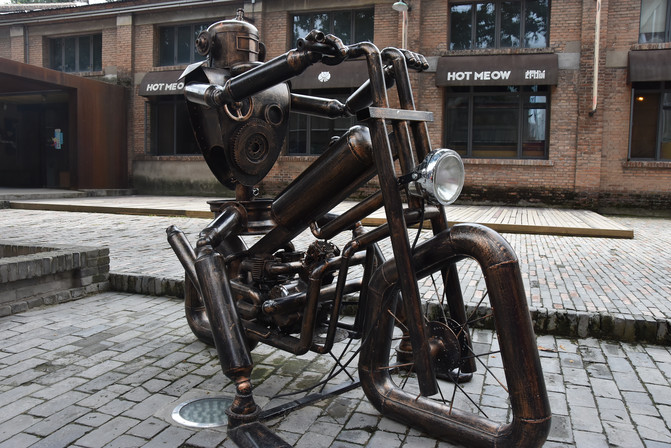


History always gives people a kind of respect and makes people willing to pay attention and think. Go around Dahua 1935, the seemingly silent park, and find a kind of peace in the noisy city.
[Daming Palace Relics Park]
Daming Palace was the most magnificent palace complex in the Tang Empire and the largest palace complex in the world at that time. It was a national symbol of the Tang Dynasty. Daming Palace was first built in the eighth year of Zhenguan of Emperor Taizong of the Tang Dynasty and was destroyed in the late Tang Dynasty, covering an area of 3.2 square kilometers.
Since they were all repaired later, there is no need to come here specially. We stopped by the door after visiting Dahua 1935.









[Yongxingfang]
In recent years, Yongxing Square has become a new Internet celebrity in Xi'an. What are its characteristics? What is the difference between it and Hui Street?
The food on Hui Street is mainly beef and mutton, Hui snacks, Hui characteristics and small accessories. Yongxingfang is a delicacies from all over Shaanxi, including specialty snacks from Yulin, Yan 'an, Baoji, Xianyang, Hanzhong, Ankang and other places. In addition, there are also leisure places such as tea drinking and folk performances. The catering and utensils of Hui Street are all operated by Hui people and have halal characteristics. Yongxing Square takes Shaanxi national culture as its connotation and ancient architectural communities in the Ming and Qing Dynasties as its carrier.
▼Yongxingfang is located in Shuncheng Lane on the north side of Zhongshanmen in Xi'an City Wall. It covers an area of 15 acres. More than 1,400 years ago, Wei Zheng, a well-known remonstrant in Chinese history, lived here.




Yongxing Square plaque Yongxing Square brings together more than 50 specialty food operators from all over Shaanxi, including provincial-level intangible cultural heritage food, city-level intangible cultural heritage food, handmade folk arts performances and snacks of various places.




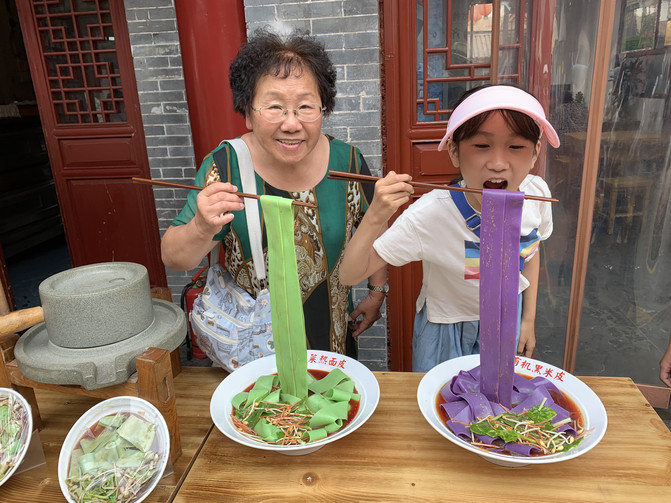



Tourists can not only experience the style of "Tangcheng 108 Square" in Yongxing Square, but also taste authentic Shaanxi folk snacks; and purchase local specialties, delicacies and tourist souvenirs processed with old folk crafts in the place of origin and on site.









► The most popular bowl wine



[Big Wild Goose Pagoda North Square]
The North Square of the Big Wild Goose Pagoda is mainly famous for its musical fountains. The largest fountain square in Asia has a "reservoir" underground that is like a "swimming pool" the size of two football fields.
Music fountain opening hours
Monday to Friday: 12:00, 20:00 Saturday, Sunday and holidays: 10:00, 12:00, 14:00, 16:00, 18:00, 20:00





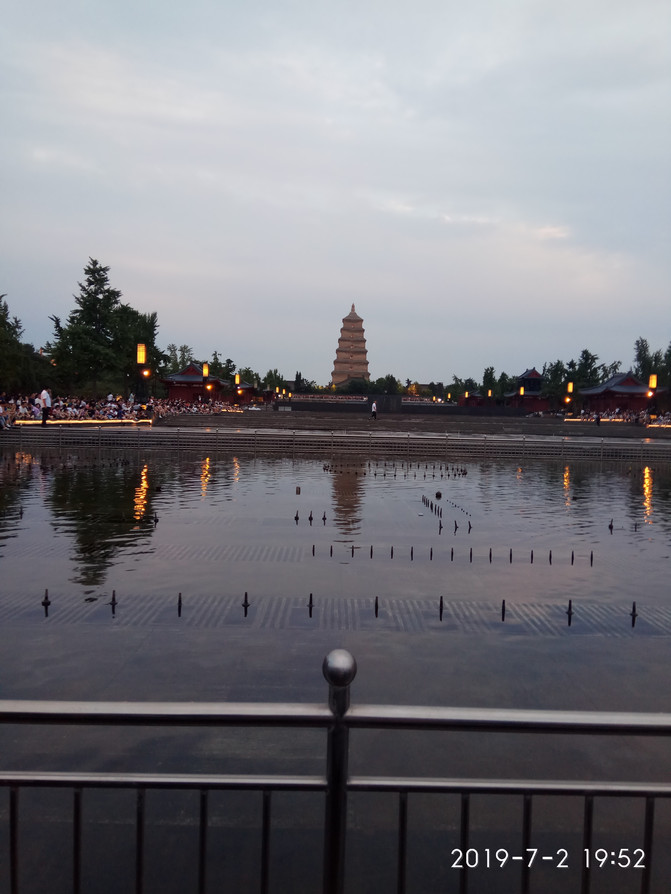


[Big Wild Goose Pagoda South Square]
Built in front of Dacien Temple, it is an interpretation of Buddhist culture. The landmark building is the vertical statue of Xuanzang. The surrounding area is supplemented by facilities such as garden green spaces and water bridges, making it a common place for citizens to relax and relax. There are many restaurants of various styles in and on both sides of the square.

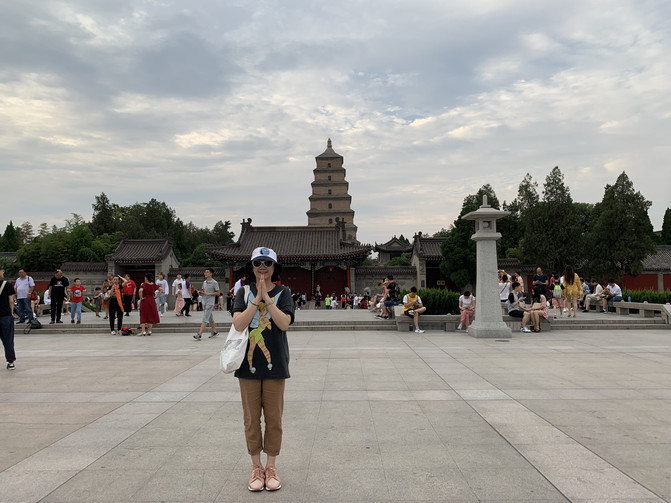
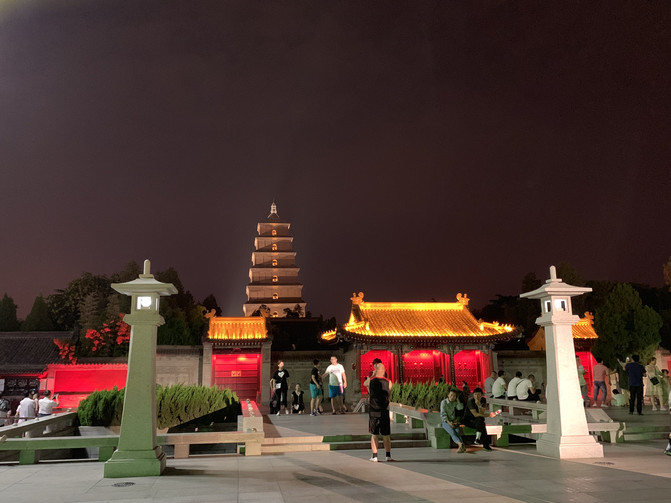
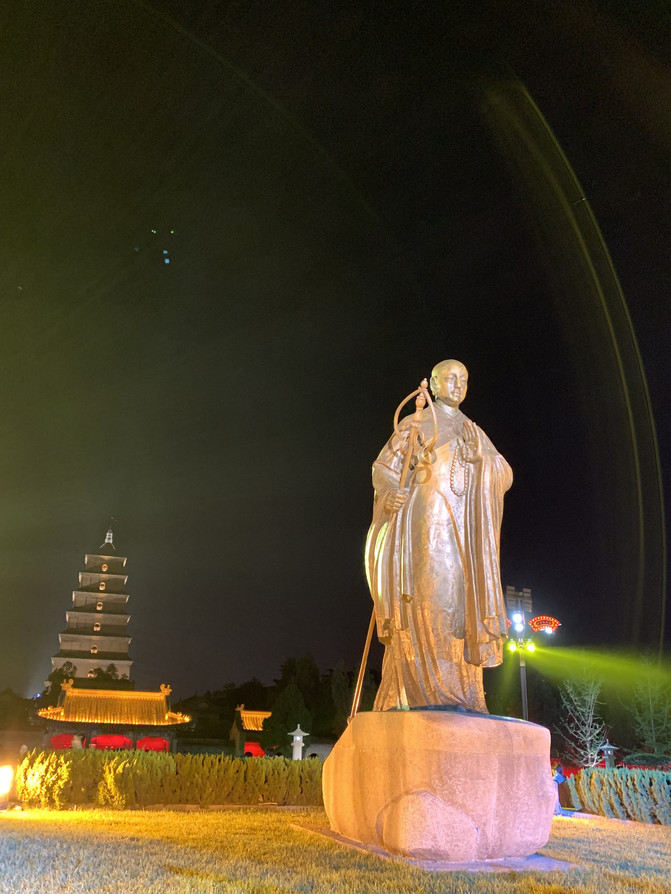
Starbucks


▼[Tang Dynasty Sleepless City]
The Tang Dynasty Sleepless City is located just south of the Big Wild Goose Pagoda and can be reached by heading south from the South Square.
There are both exquisite Chinese gardens representing Tang culture and buildings with very different styles. With a total length of 1500 meters, it can be called the largest scenic avenue in Asia. There are 9 groups of themed sculptures, including emperors in prosperous times, historical figures, heroic stories, and classic art works.
The Tang Dynasty never sleeps at night attracts the tourists that follow suit. The city that never sleeps in the Tang Dynasty is full of lights, and the antique buildings in the light and shadow are full of brilliance and magnificent, as if the prosperous age of the Tang Dynasty is reproduced. It is beautiful and known as the most beautiful street.









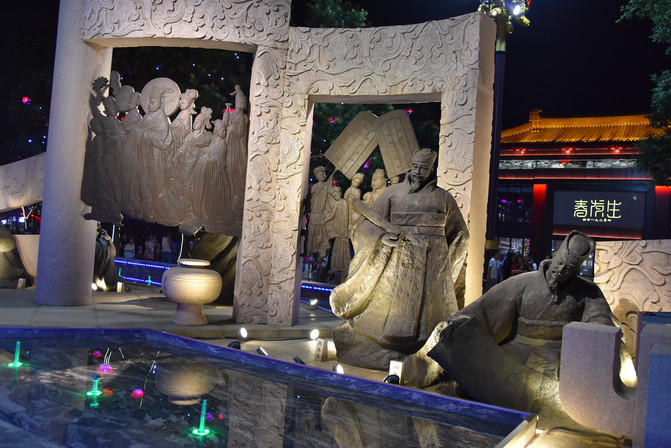






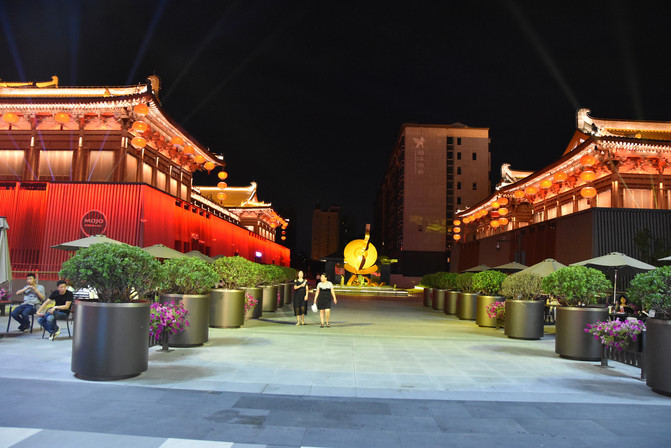




At the same time, it has also become one of the holy places for local people to consume entertainment. Cultural landmarks such as Xi'an Concert Hall, Qujiang Art Museum, Shaanxi Grand Theater, and Pacific Studios are also based here.






















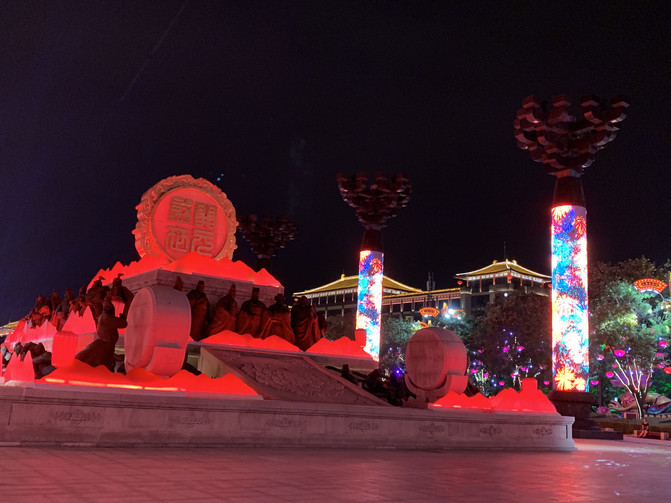
The last night was in Xi'an. The Tang Dynasty never let me down. Xi'an at night was the most historical, storied, and lively... Stroll until 12 o'clock before returning home.
D5: Shaanxi History Museum--Beautiful meal-Red-eye flight back to Shanghai
[Shaanxi History Museum]
This is not the first time I have come to the Shaanxi History Museum. Every time I come, I look at it carefully like the first time.
I made an appointment on the official website one week in advance. This crowd made me re-examine the popularity of the Shaanxi History Museum.
I originally planned to hire a tour guide, but the service desk had to queue up to draw numbers. So a group of six of us spent 30 yuan each to rent an interpreter to visit, so that we could taste it slowly.
Today, I mainly introduce some of the "treasures of the town" of the Shaanxi History Museum. (Except for the agate cup with the beast's head placed in the special exhibition hall, the polo map, and the hunting trip map, I have seen most of them.)
► The Western Zhou Dynasty Ding
The yú tripod of the Western Zhou Dynasty is a cultural relic of the early Western Zhou Dynasty (11th century BC-mid-10th century BC). It was unearthed in Yangjia Village, Mei County, Baoji City, Shaanxi Province in 1972 and is now collected in the Shaanxi History Museum. The Western Zhou Dynasty Ding has a height of 77 centimeters, a diameter of 56.5 centimeters, and a weight of 78.5 kilograms. The Ding was cast during the period of King Kang of the Western Zhou Dynasty. It inherits the style of the round Ding of the Shang Dynasty. It has a noble, majestic, heavy and solemn shape, solemn, magical, gorgeous and exquisite decoration. It is an outstanding bronze ware.
◆ Five Sacrifices to Wei Ding


Wusi Wei Ding is a cultural relic of the middle Western Zhou Dynasty (about the middle of the 10th century BC to the middle of the 9th century BC). It was unearthed in Dongjia Village, Qishan County, Baoji City, Shaanxi Province in 1975 and is now collected in the Shaanxi History Museum. The Five Sacrifice Wei Ding has a height of 36.5 centimeters, a diameter of 34.3 centimeters, a belly depth of 19.5 centimeters, and a weight of 11.5 kilograms. Although the shape of the tripod is simple and the shape is simple, the inscriptions on the abdomen have unparalleled historical value and are known as the "Bronze History Book".
○ Gilded gold and silver bamboo copper fumigation furnace



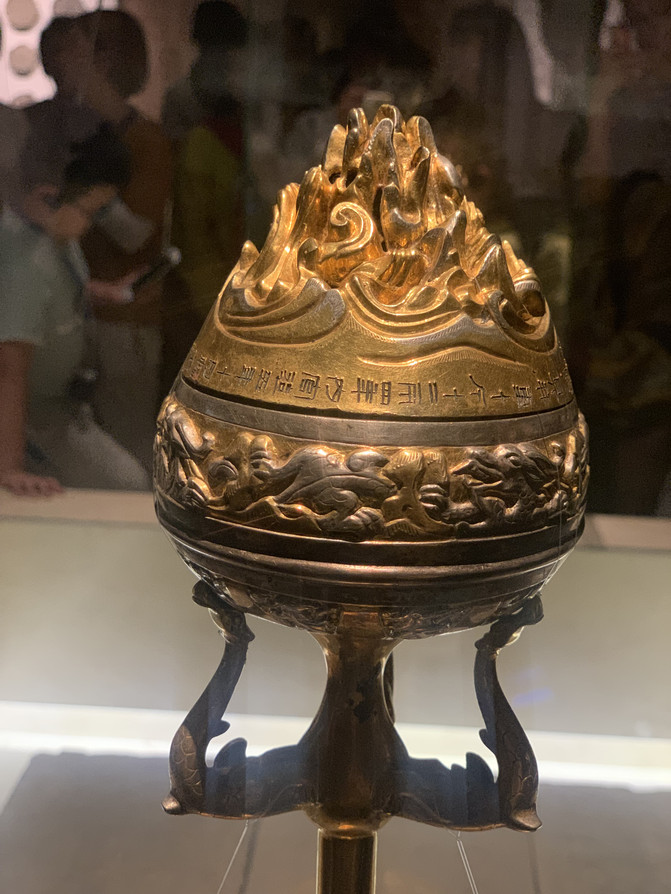

Gilt gold and silver bamboo bamboo copper smoked stove, a cultural relic of the Western Han Dynasty (202 BC-8 AD), was unearthed in 1981 in the burial tomb on the east side of Maoling in Xingping City, Shaanxi Province, and is now collected in the Shaanxi History Museum. The gold and silver slub copper fumigation furnace has a height of 58 cm and a diameter of 9 cm. This smoking stove is made of bronze and is made of casting and riveting the furnace body, long handle and base. The whole body is gilded with gold and parts are gilded with silver. It is carefully carved and has a gorgeous shape. It is a rare piece of art.
► Empress Jade Seal



The Empress's Jade Seal is a cultural relic of the Western Han Dynasty (202 BC-8 AD). It was unearthed in Langjiagou Village, Xianyang City, Shaanxi Province in 1968 and is now collected in the Shaanxi History Museum. The seal surface of the jade seal is square, 2 cm high, 2.8 cm side length, and 33 grams. On the jade seal is carved a crawling chi-tiger as a button. The four characters "Seal of the Queen" are engraved in seal script on the seal surface. The calligraphy is rigorous and smooth, the strokes are of uniform thickness, and the knife skills are naturally skillful. It can be seen that the art of seal cutting at that time had reached a superb level. The Empress 'Seal is still the highest-ranking and only imperial seal discovered so far during the Han Dynasty. It is also the earliest imperial seal in China. It is of great significance and precious to the study of the imperial seal system of emperors and empresses in the Qin and Han Dynasties.
◆ Golden bowl with mandarin duck lotus petals pattern


The golden bowl with mandarin duck lotus petals is a cultural relic of the Tang Dynasty (618 - 907). It was unearthed in the cellar of Hejia Village in the southern suburbs of Xi'an City in 1970 and is now collected in the Shaanxi History Museum. There were two gold bowls with mandarin duck lotus petals patterns when they were unearthed. The shapes and decorations of the two bowls were the same. Pure gold, made of hammering, and the shape is full and solemn. The golden bowl is 5.5 cm high, 13.7 cm in diameter, 6.8 cm in diameter and 392 grams in weight. The other piece is 5.6 centimeters high, 13.5 centimeters in diameter, 6.8 centimeters in diameter, and weighs 391 grams. The golden bowl with mandarin duck and lotus petals is one of the most magnificent and exquisite objects known in the Tang Dynasty. It is a masterpiece combining Western gold and silver craftsmanship with Eastern aesthetics. It is also one of the few but not the only cultural relics, both of which are national treasure level cultural relics.
○ Gilded silver jar with parrot pattern and beam lifting

The gilded silver cans with parrot patterns were unearthed in the Tang Cellar Collection in Hejia Village, Xi'an City in October 1970. The cans are made of pure silver, with a height of 24.1 cm, a diameter of 12 cm, a foot diameter of 14.4 cm, a wall thickness of 0.15 cm, and a weight of 1879 grams. This silver jar is the most magnificent and exquisite silver cans ever discovered in the Tang Dynasty. It is a rare treasure that perfectly combines practicality and artistry, and a national treasure cultural relic.
◆ Tang Sancai camel carrying music figurines
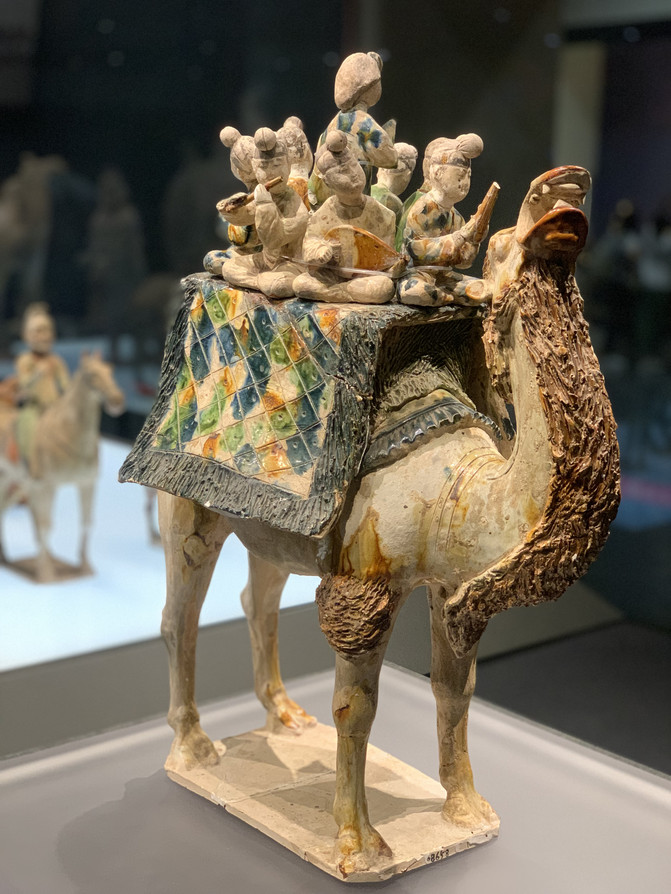
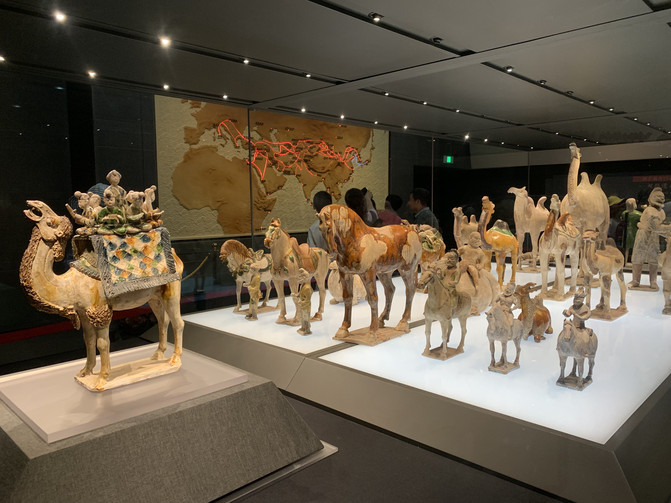
The three-color camel carrying music figurines of the Tang Dynasty are cultural relics of the Tang Dynasty (618 BC-907 AD). They were unearthed in the Tang tomb in Zhongbao Village, the western suburbs of Xi'an City, Shaanxi Province in 1959. They are now collected in the Shaanxi History Museum. The three-color camel music-carrying figurines represent the image of a touring orchestra that came with camels walking around and singing. The height is 58 cm, the length is 41 cm, and the camel height is 48.5 cm. There are 8 music and dance figurines on the camel, 7 male music and 1 female dance figurines. The artist boldly used romantic and exaggerated techniques, using a narrow hunchback as the stage, but carrying a large band to express the popular new dance music at that time. It was full of imagination and unique. The whole work is novel and romantic in shape, superb in production technology, bright and beautiful in glaze color, harmonious and natural, vivid in characters, and lifelike in shape, making people feel as if they have heard melodious music. It can be called the best in the Tang Dynasty Sancai. The music carrying figurines not only have high artistic appreciation value, but also have important reference value for our research on music, singing and dancing, and cultural exchanges between China and foreign countries during the Tang Dynasty.
► Green glaze lifting beam pouring pot

The green glaze lifting beam inverted pot is a cultural relic of the Five Dynasties (907 - 960). It was unearthed in Bin County, Shaanxi Province in 1968 and is now collected in the Shaanxi History Museum. The green glaze and beam inverted pouring pot is 18.3 cm high, 14.3 cm in diameter, 12cm in depth, and 7.5 cm in diameter. Since the pot has no mouth and no cover, there is only a plum blossom shaped injection port in the center of the bottom of the pot. When using it, the pot must be inverted and the wine is injected into the ampulla belly through the plum blossom holes on the bottom of the pot. Therefore, it is called the "inverted pouring pot", also called the reverse flow pot or the inverted flow pot. The blue-glaze and beam-lifting pot is a high-quality product produced in Yaozhou Kiln during the Five Dynasties.
► Qin·Painted kneeling and shooting figurines:


Unearthed in the Mausoleum of Qin Shi Huang, the faces and necks of the figurines are yellow-green, which has considerable archaeological value.
► Du Hufu:


For cultural relics from the Warring States Period to the Qin Dynasty, tiger talismans originated very early as a certificate for mobilizing troops in Chinese history. The story of Lord Xinling's "stealing talismans to save Zhao" shows that tiger talismans were already in use during at least the Warring States Period.
◆ Dugu Xin Polyhedral Coal Essence Group Seal



► Golden Monster


► Tang Dynasty grape flower and bird pattern silver sachet

◆ Tilang Silver Tea Cage


◆ Ming Dynasty painting relies on the figurines



Rijigong



Anjia Tomb Stone Bed


Three-colored horse-leading figure and three-colored horse

Gilded copper silkworm


Yanyu copper lamp


There are also many treasures of the town hall. Since there is no introduction, we can only display pictures. We will definitely go again in the near future.




► Museum building
The overall situation fully reflects the design ideas of the design master Zhang Jinqiu, deliberately highlights the style of the Tang Dynasty, and reflects the style of the broad and glorious era of the Tang Dynasty. The whole building has clear primary and secondary areas, scattered and concentrated, highlighting the simple and dignified style, creating an atmosphere of combining ancient imperial palaces and traditional gardens, and recreating the integration of traditional culture and modern technology.




[Zhuba City]
With the passage of time, Zhuba City has become the city symbol of Xi'an. It is precious not only because it has a name with a history of five to six centuries, but also because it is a unique commercial street.
Zhuba City Street is facing the South Gate Cave of the Drum Tower. Standing on the street, you can see the tall figure of the Drum Tower through the layers of dense canopy.
► Qingqu Society

▲ Fanji Roujiamo

► Drunken Chang 'an

Every dish is so delicious, I just hate that my appetite is too small at this time.



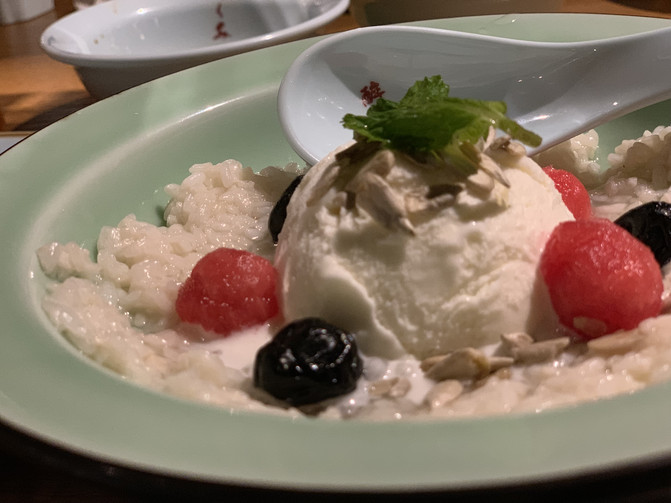






[People's Theater]




Xi'an is full of cultural relics and historic sites. I can only spy on a corner at a time and have the opportunity to continue the perfect journey.
As the old rule, all travel notes are connected:
1. Travel abroad
1. Langkawi Strategy you.ctrip.com/travels/langkawi539/1016962.html
2. Young and old travel to Australia on the 12th day (with detailed strategy and itinerary attached)
http://you.ctrip.com/travels/melbourne312/2312129.html
3. 6-day parent-child free travel in Bali (with detailed instructions and itinerary)
http://you.ctrip.com/travels/bali438/2582743.html
4. France, Italy and Sweden 13-day parent-child tour (including an in-depth tour of Italy, with detailed itinerary and massive photos attached) you.ctrip.com/travels/italy100026/2824225.html
5. Exploration of Quantum, 5 days and 4 nights of parent-child carnival
http://you.ctrip.com/travels/seoul234/3113286.html
6. Let me go to Macau again and again. On the 3rd, I will show you a different Macau.
http://you.ctrip.com/travels/macau39/3300511.html
7. Celebrating the Spring Festival with joy, a three-day parent-child tour in Macau
http://you.ctrip.com/travels/macau39/3343413.html
8. 19-day parent-child free travel tour in the western United States (San Francisco, 17 Mile, Los Angeles, San Diego, Las Vegas, Grand Canyon, Antelope Cave, Yellowstone Park)
http://you.ctrip.com/travels/losangeles250/3616901.html
9. Universal Studios 'latest and strongest strategy
http://you.ctrip.com/travels/1447450/3641902.html
10. One of the favorite towns in the American West: Pacific Grove Butterfly Town)
http://you.ctrip.com/travels/sanfrancisco249/3641383.html
11. Two of my favorite attractions during a trip to the United States: Hearst Castle
http://you.ctrip.com/travels/sansimeon34571/3642815.html
12. The third favorite attraction during a trip to the United States: Barboa Park
http://you.ctrip.com/travels/sandiego1954/3642816.html
13. Four of my favorite attractions during a trip to the United States: Getty Center
http://you.ctrip.com/travels/losangeles250/3642677.html
14. Five of my favorite attractions during a trip to the United States: Hoover Dam and Grand Canyon Park
http://you.ctrip.com/travels/nevada21658/3642883.html
15. Six of my favorite attractions during a trip to the United States: San Diego's Kiss of the Century and Old Town of San Diego
http://you.ctrip.com/travels/1700594/3648147.html
16. Food eaten in the western United States
http://you.ctrip.com/travels/unitedstates100047/3647673.html
17. Japan, here I come!! Osaka, Nara, Kobe, Himeji Castle, and Kyoto have a 9-day in-depth tour, with countless beautiful scenery during the cherry blossom season
http://you.ctrip.com/travels/osaka293/3675037.html
18. Six-day parent-child museum trip during the Japanese summer vacation (there are also pictures of feeding deer beautifully and photos of playing on the ranch)
http://you.ctrip.com/travels/kyoto430/3702161.html
19. Winter in Hokkaido is so beautiful (8th parent-child tour)
https://you.ctrip.com/travels/sapporo1878/3773549.html
2. Domestic travel:
1. Xiamen 4-day parent-child train tour you.ctrip.com/travels/gulangyu120058/2061246.html
2. Happy Ice and Snow Tour in Northeast China (practical guide for parent-child on 5 days and 4 nights)
http://you.ctrip.com/travels/haerbin151/2262168.html
3. Happy Beijing Parent-Child 3-Day Tour (with detailed guide and itinerary)
http://you.ctrip.com/travels/beijing1/2392052.html
4. Marvel at the profoundness and profoundness of Tibetan Buddhism and the picturesque scenery of Xizang (enclosed with detailed strategies and anti-plateau secrets) you.ctrip.com/travels/lhasa36/3036521.html
5. Visiting Xi'an during the Qingming Festival--4 days and 3 nights to watch and eat Xi'an classics you.ctrip.com/travels/xian7/3113778.html
6. One-day trip to Pingjiang Road, Suzhou you.ctrip.com/travels/suzhou11/3372053.html
7. Wuyuan 4 days and 3 nights-a place that combines cultural and natural landscapes in the most harmonious way (massive amount of beautiful photos) you.ctrip.com/travels/wuyuan446/3427537.html
8 Yangzhou 3-day parent-child tour (Ancient Canal, Geyuan, Heyuan, Slender West Lake, Dongguan Street and many Internet celebrity delicacies)
http://you.ctrip.com/travels/yangzhou12/3706665.html
9. 3-day parent-child tour in Hefei, Anhui Province (Li Hongzhang's former residence, Bao Park, Zhongyinyu City Cultural Street, Sanhe Ancient Town, Anhui Province Museum)
http://you.ctrip.com/travels/hefei196/3719836.html
10.[Alpine Meadow Beautiful Sea of Clouds and Stars in the Sky] Parent-Child Walking Tour for 3 Families in Beautiful Wugong Mountain (3 days and 2 nights on National Day)
http://you.ctrip.com/travels/wugongshan1445145/3735691.html
11. Dali, a place that must visit once in a lifetime (5-day tour of Dali in October)
http://you.ctrip.com/travels/dali31/3753076.html
12. A lazy two-day tour in Yangzhou in winter (Skinny West Lake)
https://you.ctrip.com/travels/yangzhou12/3766234.html
13. Shanghai Chongming Dongping Forest Park RV Parent-Child Two-Day Tour
https://you.ctrip.com/travels/shanghai2/3793792.html
14. 5-day tour of Hangzhou, a niche
https://you.ctrip.com/travels/hangzhou14/3818316.html
15. Xi'an-the other side of warmth, literature and art (another 5-day tour)https://you.ctrip.com/travels/xian7/3873729.html
3. Disney-related travel notes:
★ Ling Ma's painstaking work: Shanghai Disney's most complete and complete guide, super detailed dry goods
http://you.ctrip.com/travels/shanghaidisneyresort1446916/3503569.html
★ How to take beautiful photos when going to Disneyland?
http://you.ctrip.com/travels/shanghai2/3543742.html
1. Shanghai Disney Play Serialization (1) Detailed guide for the first time
http://you.ctrip.com/travels/shanghaidisneyresort1446916/3399685.html
2. Shanghai Disney Play Serialization (2) Play in a downpour for a day
http://you.ctrip.com/travels/shanghaidisneyresort1446916/3413134.html
3. Shanghai Disney Play Serialization (3) Massive Photos
http://you.ctrip.com/travels/com24647/3423680.html
4. Shanghai Disney Play Series (4)-Costume with Heart
http://you.ctrip.com/travels/shanghaidisneyresort1446916/3421533.html
5. Shanghai Disney Tour Serialization (5)-Half-day Tour Guide
http://you.ctrip.com/travels/shanghaidisneyresort1446916/3441345.html
6. Shanghai Disney Play Serialization (6)(also the first time I played from morning to night, and I swiped the event 10 times)
http://you.ctrip.com/travels/shanghaidisneyresort1446916/3445788.html
7. Shanghai Disney Play Series (7)--Signature of Disney characters
http://you.ctrip.com/travels/shanghaidisneyresort1446916/3466667.html
8. Shanghai Disney Play Serialization (8)--Play all day on the Dragon Boat Festival
http://you.ctrip.com/travels/shanghaidisneyresort1446916/3480948.html
9. Shanghai Disneyland Serialization (9)-Playing just for eating and drinking
http://you.ctrip.com/travels/shanghai2/3494137.html
10. Shanghai Disneyland Serialization (10)-Colorful Dream Salon and Royal Banquet Hall
http://you.ctrip.com/travels/shanghai2/3497948.html
4. Shanghai Urban Area, Paradise Tour
1. Shanghai Chocolate Park you.ctrip.com/travels/shanghai2/3208637.html
2. History of Shanghai Racecourse (1) you.ctrip.com/travels/shanghai2/3131675.html
3. History of Shanghai Racecourse (2) you.ctrip.com/travels/shanghai2/3320490.html
4. History of Shanghai Racecourse (3) you.ctrip.com/travels/shanghai2/3322135.html
5. History of Shanghai Racecourse (4) you.ctrip.com/travels/shanghai2/3322334.html
6. History of Shanghai Racecourse (5) http://you.ctrip.com/travels/shanghai2/3320491.htm
Previous Article:Looking for "visit" cultural relics in the forest of steles| What fine jade pieces are hidden in Xi'an Museum?
Next Article:Travel alone in the late autumn of 2019
